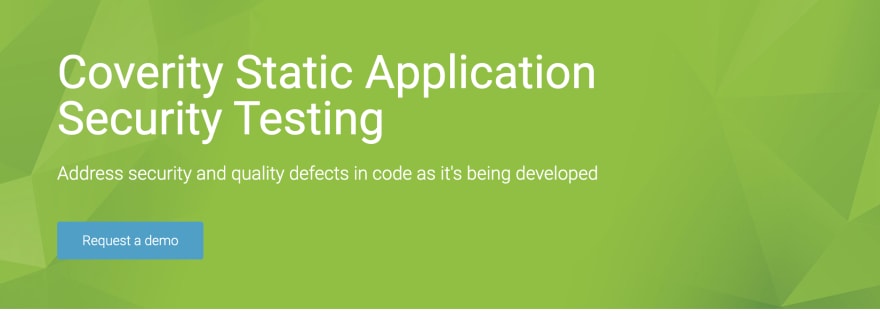Static Application Security Testing (SAST) is a set of technologies used to inspect the source code of any application to discover security vulnerabilities. SAST is classified under white-box testing because the tester has access to the codes and the internal structure of the application.
This is in contrast with Dynamic Applications Security Testing (DAST) where which the application is tested while running. The purpose of DAST is to discover loopholes that can cause the application to be attacked.
These security vulnerabilities found after testing can be SQL Injections, Cross-site Scripting, vulnerabilities from other components, and many more as listed in the OWASP Top Ten Security Risks.
Application attackers use the potential vulnerabilities in your application to push their attacks. These vulnerabilities may not be obvious to the developer until the harm is done. With SAST tools, developers or administrators get a quick evaluation of their application's security before it is deployed to production.
Static Application Security Testing is a best practice to help teams deliver reliable applications in short periods.
There are a lot of SAST tools out there, each unique in its own way. In this article, we'll look at the top 8 of them.
1. CodeSonar
CodeSonar is a SAST tool that is fast and scales easily. It is integrated into software development environments to speed up the development of applications.
CodeSonar does not only detect problems but also provides more information on the problems to help developers understand the problem better and resolve it.
2. CodeScan
CodeScan is made exclusively for Salesforce Developers - developers who work on salesforce platforms or salesforce cloud technology.
CodeScan ensures compliance with coding standards, coding quality, and increased development.
Codescan can be used as a self-hosted solution, a cloud solution, and can also be integrated into IDEs which provides feedback as you code.
3. Klockwork
Klockwork is a SAST tool for* C, C++, C#, and Java. *KlockWork provides rapid results while maintaining accuracy. Klockwork integrates seamlessly with CI/CD pipelines thereby supporting continuous automation of tests with security standards. This means on every commit, you get an immediate evaluation of your application's security level.
Klockwork can also be integrated with IDEs. This makes it even easier to detect security flaws during the development of your application.
4. PT Application Inspector
PT Application Inspector combines several scanning methods like SAST, DAST, and so on to provide accurate results and ensure reliable applications. The inspector can be used on small applications like static websites to big applications that involve cloud services.
With this inspector, vulnerabilities can be prioritized depending on their exploitation potential, that is, if a vulnerability cannot be exploited, it is not prioritized over those that can.
PT AI achieves this by testing (imitating an exploit) vulnerabilities, This way, you focus more on harmful vulnerabilities.
5. Coverity
Coverity helps to detect security issues early in the software development life cycle of an application. It also tracks and manages risks of vulnerabilities. It also helps to ensure that the application's source code complies with security and coding standards.
It can be integrated into development environments thereby providing real-time feedbacks and solution recommendations for errors discovered during development.
Coverity can also be integrated into CI/CD pipelines and it interacts well with API integrations.
6. Checkmarx
Checkmarx is an enterprise tool for identifying and providing solutions for vulnerabilities in enterprise applications. There are over hundreds of vulnerabilities that Checkmarx can identity.
Checkmarx supports over 25 languages and frameworks and requires no configurations to start scanning.
Checkmarx also has a "Best Fix Location" feature which allows developers to resolve multiple vulnerabilities at one point.
7. HCL AppScan CodeSweep
HCL AppScan CodeSweep is a lightweight and free SAST tool used as an extension in development environments to detect security vulnerabilities during application development. It supports various languages and frameworks from PHP, to Kotlin, to JavaScript, and so on.
8. HCL AppScan Source
HCL AppScan performs security vulnerability testing directly in your development environment. It also has a comprehensive report and management of your application's source code.
It can also be integrated into IDEs and CI/CD pipelines to scan applications before they are moved to production.
With machine learning, AppScan can quickly identify critical security vulnerabilities and the best solutions for them. This helps to prevent costly fixes later in the development cycle.
Conclusion
In this article, we looked at what SAST is and briefly looked at DAST. Also, we looked at the top 8 SAST tools.
SAST tools are very important for applications. The manual methods may not be reliable and these SAST tools are automated, thereby making them better. Attackers use vulnerabilities to exploit companies through the applications and this can also affect the users.
With SAST solutions like above, you can build applications rapidly with security in check. Most of these tools have free options and these free options may be more than enough for your application.
Cover Photo by Oskar Yildiz on Unsplash















Top comments (0)